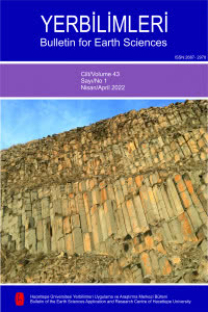Kabuk anizotropi araştırmalarında deprem sürülerinin istatistiksel analizi
Simav, sismik anizotropi, kayma dalgası ayrımlanması, stres, b değeri
Statistical analysis of the earthquake swarms in crustal anisotropic investigation
Simav, seismic anisotropy, shear wave splitting, stress, b-value,
___
- Anderson, D., 1989. Theory of the Earth, Blackwell Sci. Cambridge, Mass. 366pp.
- Agius, M.R., Lebedev, S., 2017. Complex, multilayered azimuthal anisotropy beneath Tibet: evidence for co-existing channel flow and pure-shear crustal thickening. Geophysical Journal International, 210(3), 1823–1844.
- Faccenna C., Bellier O., Martioned J., Piromella and V. Regard, 2006. Slab detachment beneath Eastern Anatolia: A possible cause for the formation Of the North Anatolia Fault, Earth and Planetary Science Letters 242, 85-97.
- Hatzfeld, D., (2001). Shear wave anisotropy in the upper mantle beneath the Aegean related internal deformation, J. Geophys. Res., 106, 30 737-30 754.
- Hellfrich, G., and Brodholt, J., 1991. Relationship of deep seismicity to the thermal structure of subducted lithosphere, Nature, 353, 252-255.
- Gündoğdu, E., Özden, S., Kurban, Y. C., & Yalçıner, C. Ç., 2017. Simav Fayındaki Düşey Yerdeğiştirmelerin, Yeraltı Radarı (GPR) Yöntemi ile Belirlenmesi.
- Jarahi, Hadi. (2017). Delineate Location of the Last Earthquake Case Study NW of Iran. American Journal of Geosciences. 7. 7-13. 10.3844/ajgsp.2017.7.13.
- Kaneshima, S., and Silver, P.G., 1992, A search for source side mantle anisotropy, Geophys. Res. Lett., 19(10), 1049-1052.
- Karato, S., 1992. On the Lehmann discontinuity, Geophys. Res. Lett., 19, 2255- 2259.
- Kennett, B. L. N., 1991. The removal of free surface interactions from three-component seismograms, Geophys. J. lnt., 104, 153-163.
- Mainprice, D. and Silver, P. G., 1993, Interpretation of SKS-waves using samples from the subcontinental lithosphere, Physics of the Earth and Planetary Interiors, Volume 78, Issue 3-4, p. 257-280.
- Nuttli, O., 1961. The effects of the Earth's surface on the S wave particle motion, Bull. Seismol. Soc. Am., 51, 237-246.
- Ringwood, A. E. and Kesson, S. E., 1976, Limits on the Bulk Composition on the Moon, Abstracts of the Lunar and Planetary Science Conference, volume 7, page 741.
- Russo, R.M., and Silver, P. G., 1994. Trench parallel flow beneath the Nazca plate from Seismic anisotropy, Science, 263, 1105-1111.
- Sandvol, E., Ni, J., and Kind, R., 1997. Azimuthal Anisotropy Beneath the Southern Himalayas-Tibet Collision Zone, Journ. Geophys. Res., 102, p. 17813-17823.
- Silver, P.G. and Chan, W. W., 1991, Shear wave splitting and subcontinental mantle deformation, J. Geophys. Res., 96, 16429-16454.
- Spakman, W., and Nolet, G., 1988. In mathematical Geophysics (eds Vlaar, N. J. et al) 155-188 (Reidel, Dordrecht).
- Widiyantoro, S., van der Hilst, R. D., and Wenzel, F.,2004. Transition Zone Deformation of the Aegean Slab in the Mantle. International Journal of Tomography &Statistics; D04:1 14.
- Changhui Ju, Junmeng Zhao, Ning Huang, Qiang Xu, Hongbing Liu, Seismic anisotropy of the crust and upper mantle beneath western Tibet revealed by shear wave splitting measurements, Geophysical Journal International, Volume 216, Issue 1, January 2019, Pages 535–544, https://doi.org/10.1093/gji/ggy448.
- WIEMER, S., (2001). A software package to analyze seismicity: ZMAP. Seismol. Res. Lett. 72, p.373– 382.
- ISSN: 1301-2894
- Yayın Aralığı: 3
- Başlangıç: 1976
- Yayıncı: Hacettepe Üniversitesi Yerbilimleri Uygulama ve Araştırma Merkezi
Yozgat Yöresi Tüflerinin Çimento Katkısı Olarak Kullanılabilirliğinin İncelenmesi
Onur KÖSE, Mehmet Tekin YÜRÜR, Jean CHOROWICZ
Aslı ÜNAL, Nurdan İNAN, Kemal TASLI, Selim İNAN
Zigana Dağı (Gümüşhane, KD Türkiye) Dayklarının Jeokimyası ve Jeolojik Anlamı
Ferkan SİPAHİ, Mehmet Ali GÜCER, Münür Burhan SADIKLAR
Statistical Analysis of the Earthquake Swarms in Crustal Anisotropic Investigations
Kabuk anizotropi araştırmalarında deprem sürülerinin istatistiksel analizi
Kabuk Anizotropi Araştırmalarında Deprem Kümelerinin İstatistiksel Analizi
